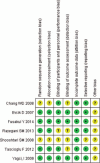Effectiveness of low-level laser on carpal tunnel syndrome: A meta-analysis of previously reported randomized trials
- PMID: 27495063
- PMCID: PMC4979817
- DOI: 10.1097/MD.0000000000004424
Effectiveness of low-level laser on carpal tunnel syndrome: A meta-analysis of previously reported randomized trials
Abstract
Background: Low-level laser therapy (LLLT) has been applied in the treatment of carpal tunnel syndrome (CTS) for an extended period of time without definitive consensus on its effectiveness. This meta-analysis was conducted to evaluate the effectiveness of low-level laser in the treatment of mild to moderate CTS using a Cochrane systematic review.
Methods: We conducted electronic searches of PubMed (1966-2015.10), Medline (1966-2015.10), Embase (1980-2015.10), and ScienceDirect (1985-2015.10), using the terms "carpal tunnel syndrome" and "laser" according to the Cochrane Collaboration guidelines. Relevant journals or conference proceedings were searched manually to identify studies that might have been missed in the database search. Only randomized clinical trials were included, and the quality assessments were performed according to the Cochrane systematic review method. The data extraction and analyses from the included studies were conducted independently by 2 reviewers. The results were expressed as the mean difference (MD) with 95% confidence intervals (CI) for the continuous outcomes.
Results: Seven randomized clinical trials met the inclusion criteria; there were 270 wrists in the laser group and 261 wrists in the control group. High heterogeneity existed when the analysis was conducted. Hand grip (at 12 weeks) was stronger in the LLLT group than in the control group (MD = 2.04; 95% CI: 0.08-3.99; P = 0.04; I = 62%), and there was better improvement in the visual analog scale (VAS) (at 12 weeks) in the LLLT group (MD = 0.97; 95% CI: 0.84-1.11; P < 0.01; I = 0%). The sensory nerve action potential (SNAP) (at 12 weeks) was better in the LLLT group (MD = 1.08; 95% CI: 0.44-1.73; P = 0.001; I = 0%). However, 1 included study was weighted at >95% in the calculation of these 3 parameters. There were no statistically significant differences in the other parameters between the 2 groups.
Conclusion: This study revealed that low-level laser improve hand grip, VAS, and SNAP after 3 months of follow-up for mild to moderate CTS. More high-quality studies using the same laser intervention protocol are needed to confirm the effects of low-level laser in the treatment of CTS.
Conflict of interest statement
The authors have no conflicts of interest to disclose.
Figures
References
-
- Werner RA, Andary M. Carpal tunnel syndrome: pathophysiology and clinical neurophysiology. Clin Neurophysiol 2002; 113:1373–1381. - PubMed
-
- Rempel DM, Diao E. Entrapment neuropathies: pathophysiology and pathogenesis. J Electromyogr Kinesiol 2004; 14:71–75. - PubMed
-
- Hirata H, Nagakura T, Tsujii M, et al. The relationship of VEGF and PGE2 expression to extracellular matrix remodelling of the tenosynovium in the carpal tunnel syndrome. J Pathol 2004; 204:605–612. - PubMed
-
- Tucci MA, Barbieri RA, Freeland AE. Biochemical and histological analysis of the flexor tenosynovium in patients with carpal tunnel syndrome. Biomed Sci Instrum 1997; 33:246–251. - PubMed
-
- Gelberman RH, Rydevik BL, Pess GM, et al. Carpal tunnel syndrome. A scientific basis for clinical care. Orthop Clin North Am 1988; 19:115–124. - PubMed
Publication types
MeSH terms
LinkOut - more resources
Full Text Sources
Other Literature Sources
Medical
Research Materials
Miscellaneous



